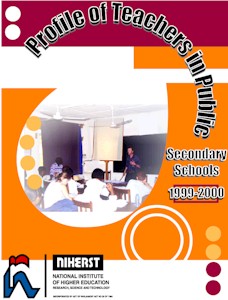
This report, which was completed in 2002, focuses on teachers in government and government assisted secondary schools. The statistics compiled in this publication represent the academic year, 1999-2000, and cover the following demographic and social characteristics of secondary school teachers: age. gender, job classification, academic qualifications, professional training, and subject area by type of school.
This comprehensive study, the only one of its kind to be undertaken in Trinidad and Tobago, provides essential data which can be utilized by educators and policy-makers in the education sector. It identifies, inter alia, teacher training as a critical area that needs to be addressed in order to improve the quality of education in Trinidad and Tobago.
Summary of Main Findings
Data Highlights
- The survey covered 5,213 teachers in 101 government and government assisted secondary schools in which 41% was male and 59% female. The average age of all teachers was 41; the average age of males was 43 while that of females was 40.
- Teachers in the 40-59 age group accounted for 56% of all teachers, with those in the 50-59 age group accounting for 20%.
- Sixty-three percent (63%) of the 5,213 teachers surveyed had a university degree, and 22% had a diploma or a certificate. Less than half of all secondary school teachers (46%) had professional training. Of this 46%, only 19% or 989 teachers were professionally trained with a university degree/diploma.
- Seventy-eighth percent (78%) of the teachers with university degrees were classified as Teachers II, the highest category. Only forty-three percent (43%) of the teachers with university degrees, classified as Teachers II, had professional training; twenty-nine percent (29%) had a university degree/diploma in education and fourteen percent (14%) a teacher's diploma.
- Fifty-seven percent (57%) of the Teachers II were untrained.
- Half of the secondary school teachers (50% or 2,581) teachers was classified as Teacher II, 12% as Teacher I, 6% as Special Teacher III and 5% for each of the Technical/Vocational Teacher II and Assistant Teacher III categories.
- The largest proportion of trained teachers (91%) mainly with a teacher's diploma was in the Teacher I category.
- Of the 2,581 teachers classified as Teacher II, females outnumbered males by almost 2 to 1, 65% to 35%.
- Of the 892 males in the Teacher II category, thirty-nine percent (39%) were trained compared to forty-five percent (45%) of the females.
- In the considered "core" areas in the curriculum, only twenty percent (20%) of the teachers in Mathematics and Computer Science were professionally trained with a university degree/diploma. Twenty-five percent (25%) and thirty percent (30%) of the teachers in Natural Science, English and English Literature respectively had professional training.
- The larger proportion of Junior Secondary School teachers (54%) did not possess a university degree.






